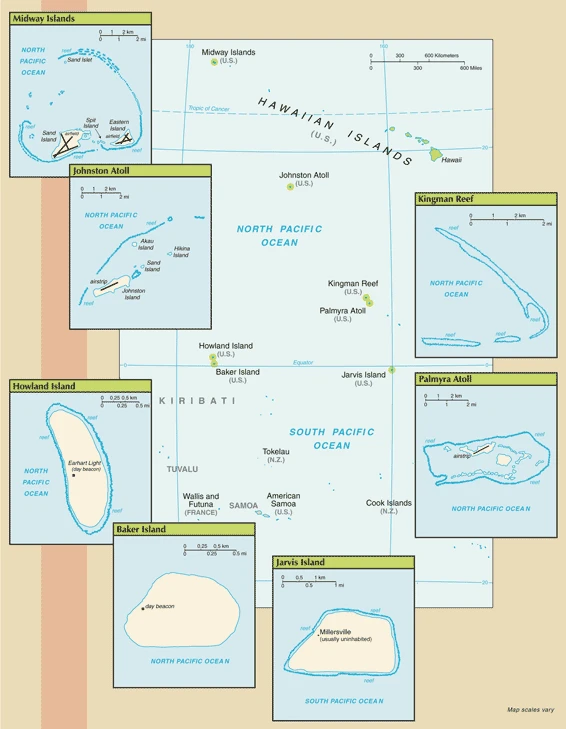Johnston Atoll Google Maps is a site/tool that offers a wide range of map views (topographic, satellite, street view) and navigation options, with little effort on your part, yet efficiently. If you need to plan a trip to a new place like Johnston Atoll, Google maps are available on desktop, mobile, or tablet. This Google maps and information page is dedicated to Johnston Atoll, Oceania (27 countries), showing its location, country facts, and plenty of other information which may be interesting when you visit this Oceanian state.
Quick links: Google Maps Johnston Atoll, Driving Directions Johnston Atoll, Printable Road Map.
About Johnston Atoll in a nutshell
- Conventional short form of the name: Johnston Atoll
- The conventional long form of the name: none
- Etymology: etymology: self-descriptive name specifying the territories affiliation and location.
- The legal system in Johnston Atoll: the laws of the US apply where applicable.
- Climate: Tropical, but generally dry, consistent northeast trade winds with little seasonal temperature variation.
- Internet TLD: N/A
Background
The US and the Kingdom of Hawaii annexed Johnston Atoll in 1858, but the US mined the guano deposits until the late 1880s. Johnston and Sand Islands have designated wildlife refuges in 1926. The US Navy took over the Atoll in 1934. Subsequently, the US Air Force assumed control in 1948. The site was used for high-altitude nuclear tests in the 1950s and 1960s. Until late 2000, the Atoll was maintained as a storage and disposal site for chemical weapons. Munitions destruction, cleanup, and facility closure were completed by May 2005. The Fish and Wildlife Service and the US Air Force discuss future management options. In the interim, Johnston Atoll and the three-mile Naval Defensive Sea around it remain under the jurisdiction and administrative control of the US Air Force.
Geography

Johnston Atoll is a small 8×6 mile coral island located in the Pacific Ocean, about 1000 miles south of Hawaii. It was initially discovered in 1816 but has been uninhabited since it served as a staging area for World War II.
This state is located in Atoll in the North Pacific Ocean 1,330 km southwest of Honolulu, about one-third of the way from Hawaii to the Marshall Islands, under the coordinates of 16 45 N, 169 31 W, with a coastline of 34 km. Johnston Atoll is About 4.5 times the size of the national mall in Washington, DC.
Low and nearly flat sandy coral islands with narrow fringing reefs that have developed at the top of submerged volcanic mountains, which in most cases rise steeply from the ocean floor, with Sand island 10 m as the highest point of Johnston Atoll, while Pacific Ocean 0 m as the lowest point.
Johnston Island and Sand Island are natural islands that have been expanded by coral dredging; North Island (Akau) and East Island (Hikina) are artificial islands formed from coral dredging; the egg-shaped reef is 34 km in circumference, closed to the public.
The climate in Johnston Atoll is as follows: Tropical but generally dry, consistent northeast trade winds with slight seasonal temperature variation.
When you visit Johnston Atoll, the natural hazards shall be considered: none.
When visiting Johnston Atoll, the following major health-threatening issues shall be considered: none.
Current environmental issues affecting the people: no natural freshwater resources; the seven decades under US military administration (1934-2004) left the Atoll environmentally degraded and required large-scale remediation efforts; a swarm of Anoplolepis (crazy) ants invaded the island in 2010, damaging native wildlife; eradication has mainly been, but not wholly, successful.
Google Maps Johnston Atoll
The capital and other divisions
Johnston Atoll is a small atoll in the Pacific Ocean and the capital of the United States territory, American Samoa. The Atoll was named after American Civil War General William Sidney Johnston.
People and society
The population in Johnston Atoll is in previous years; an average of 1,100 US military and civilian contractor personnel were present; as of May 2005, all US Government personnel had left the island, with no change. That means Johnston Atoll is the No.
Industry
No economic activity.
Johnston Atoll is rich in the following natural resources: Terrestrial and aquatic wildlife.
Johnston Atoll Driving Directions
In this post, you learned about Johnston Atoll, an Atoll in the North Pacific Ocean 1,330 km southwest of Honolulu, about one-third of the way from Hawaii to the Marshall Islands.
Are you interested in visiting Johnston Atoll and looking for driving directions? Click here to plan your route, or see a printable road map of Johnston Atoll below for an overview of the route network.
Printable map of Johnston Atoll

Did you know about Johnston Atoll?
Johnston Atoll is uninhabitable because there are no natural freshwater sources on the Atoll or any agricultural land.
Johnston Atoll is a small group of islands on the Southern end of the Hawaiian archipelago. The smallest and southernmost inhabited island of Johnston Atoll is Johnston Island. The primary industry on Johnston Island is running the airport that services the region. In addition, there’s an aircraft repair facility, a weather station, and a post office. The Atoll also has some plants for catching fish for food and bait.
The United States first discovered Johnston Atoll when it was under Spanish rule in 1802 by a brig owned by American merchant Benjamin Morrell. From 1840 to 1859, it was used mainly as a whaling station, and in 1944, it was designated as one of the sites to launch U2 spy planes.
After virtually visiting Johnston Atoll, you may also be interested in the neighboring country: the United States.
If you liked our Google map and Johnston Atoll information page,
please share it with others or save the link https://www.drivingdirections.net in your bookmarks.
